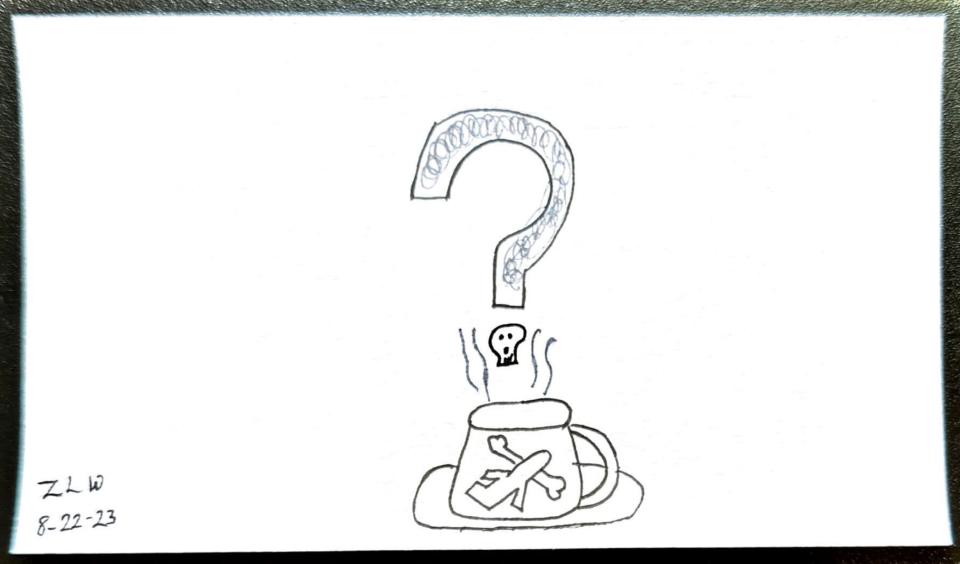Is airplane coffee safe to drink? I'll try to put the rumors to rest. | Cruising Altitude
My mom likes to refer to me as a tea snob, which is decidedly not true – as evidenced by the fact that I regularly order tea while flying.
That tea, while often nasty, is still satisfying.
But I have to admit that every time I ask for tea during the beverage service, I get a nagging feeling that I’m making a (possibly life-threatening) mistake. A little voice in the back of my mind reminds me that ordering tea or coffee in the air is not a good idea because, the rumor goes, the water that’s used to make your warm beverages onboard may not be so potable after all.
I’m hardly alone in my suspicion.
Jayne Singer, a retired special education teacher and still-competitive swimmer in Park City, Utah, flies about once a month and told me she orders only prepackaged beverages onboard.
“Since childhood, my mother used to say to me, ‘Never drink beverages, never drink coffee or tea on a plane because you never know where it’s been,’ so it’s been my whole life,” she said. “I don’t trust the source where the water is coming from.”
Singer often avoids ice cubes while flying for the same reason.

But Vance Hilderman, chief technical officer of Afuzion, an aviation development and certification company, said Singer and I shouldn’t worry. According to Hilderman, it’s “100%” safe to drink tea, coffee and even water straight from the taps on modern airplanes in developed and well-regulated countries.
He said that airlines have to regularly clean the tanks that store water for onboard use, and carriers must test the drinking water periodically for harmful bacteria.
“There’s a chemical rinse they put in (the tanks). It’s not toxic. It’s not industrial hospital quality, but it’s actually quite good. It’s very doubtful that bacteria would survive. It’s equivalent to air filtering systems, HEPA systems on aircraft,” Hilderman said.
According to the Environmental Protection Agency, onboard water systems must undergo periodic quality tests and routine disinfecting. Airlines are able to set their own protocols to be approved by the agency, but the minimum requirements are for at least annual disinfection and flushing of the water tank, with at least one sample tested each month. Or, airlines can choose to disinfect and flush the system more but sample less, with quarterly disinfection and flushing and at least one sample tested annually. There are other minimum compliance options as well, and airlines are free to exceed the minimums.
Even if the tank somehow became contaminated between tests, your coffee or tea should still be safe, even if it’s served lukewarm, Hilderman said.
“For the science-minded folks, bacteria is killed about 175 degrees, it doesn’t have to boil,” he said. “On the airplane, water boils at the 7,000-foot equivalent of about 195 degrees. … If we look at the World Health Organization, bacteria is killed at 170, so all that coffee and tea is good.”
When is it riskier to drink airplane water?
According to Hilderman, it can be more dangerous to drink tap water on flights that are taking off from places where the drinking water isn’t regularly safe. And, he said, bacteria is more likely to form in the plane’s tanks if you’re taking off from a warmer climate.
So if you’re especially worried, you can always turn down the coffee on your next flight back from the Caribbean. Even still, weather-related waterborne food poisoning is exceedingly rare on airplanes.
Hilderman also said most modern aircraft don’t manufacture ice onboard. Rather, they get ice from their catering contractors on the ground, so chilled beverages aren’t really a concern.
Justin Haase, an IT director from Kasson, Minnesota, told me he flies for work once or twice a month and almost always orders coffee onboard.
“If it was a big problem, people would be getting sick or having problems with this more frequently,” he said. “Nobody’s drinking a cup of coffee and then keeling over on the plane.”
Last week's Cruising Altitude: Why most flyers say no to upgrades if it means splitting up on the plane.
Hilderman acknowledged that airlines are often left to self-enforce the regulations around water quality, but he said it’s really not an issue on major carriers in developed countries.
“You’re in good shape,” he said. “Even the old legacy aircraft, the design is 45-50 years old, but the cleaning is pretty modernized.”
And Hilderman agreed with Haase that if this were a real problem, we’d be seeing more food poisoning on airplanes.
“If you get a stomach infection, food poisoning, something like that, it’s generally fairly traceable,” Hilderman said. “We could do the same thing on an aircraft, and that would be all over the news, but it’s apparently quite rare.”
So go forth and order your mediocre caffeine fix without fear on your next flight.
Zach Wichter is a travel reporter and columnist for USA TODAY based in New York. You can reach him at zwichter@usatoday.com
This article originally appeared on USA TODAY: Is airplane coffee and tea safe to drink? | Cruising Altitude

